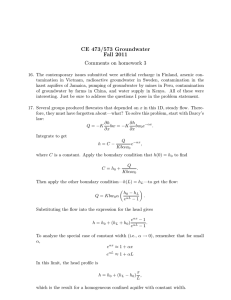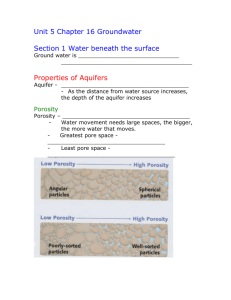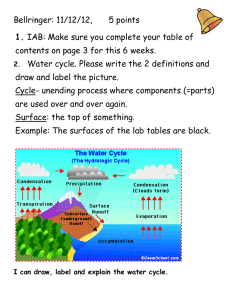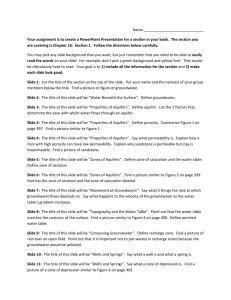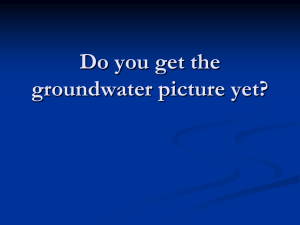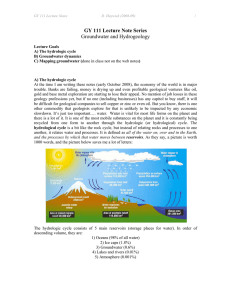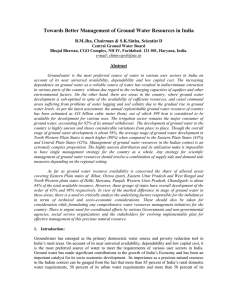Ground water Chapter 10 Pages 238-263
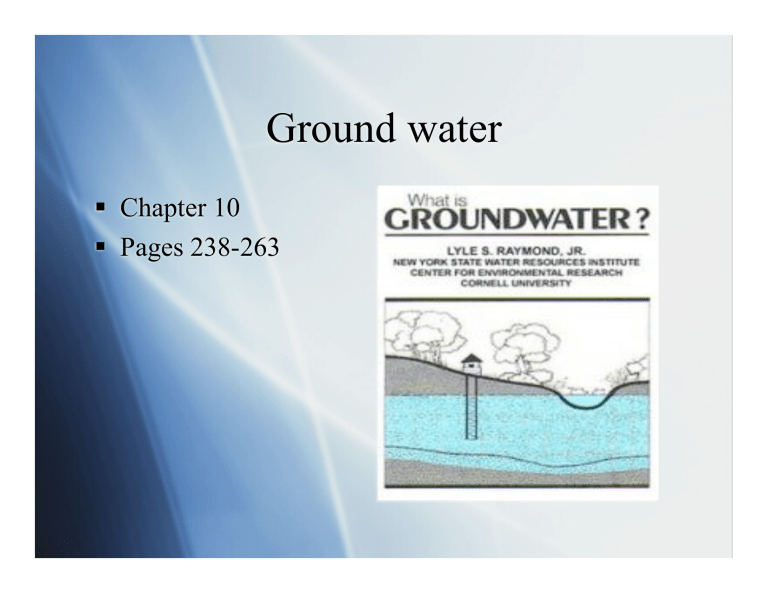
Ground water
Chapter 10
Pages 238-263
Ground water focus questions
Where does your drinking water come from?
What factors affect ground water movement and storage?
Is ground water an unlimited resource?
How much of the world’s water is fresh water?
How much of the world’s water is ground water?
Ground Water Focus Questions
How do confined and unconfined aquifers compare?
What is polluting our ground water and how can we conserve and protect it?
NATURAL RESOURCES II: WATER RESOURCES
ANNUAL MOVEMENT OF WATER ON THE GLOBE
Where’s the Water?
Water on Land
(Where is most of this held?)
Where does your drinking water come from?
Ground water
In cracks and pore spaces
Not in underground lakes and streams
GROUNDWATER
Zones
Saturated zone = where all the cracks and pore spaces are filled with water = ground water
Zone of aeration = unsaturated zone = area where there is water and air in the pore spaces and cracks
Water table = upper limit of the saturated zone
Porosity
The ability to store water in pores and cracks.
Factors affecting it
Particle shape -- rounded has more pore space than angular
Sorted sediments have more pore space than unsorted
Clay - soaks up the water slowly but holds a surprisingly large amount
Permeability
The ability to transmit water
Factors affecting it:
1.
Sizes of pores & cracks
2.
Whether pores and cracks are interconnected
3.
Capillarity - water is attracted to clay and resists moving
Aquifers
Aquifers are both porous and permeable.
Unconfined aquifer
Does not have impermeable rock above and below.
Must be pumped out
Can be contaminated from surface spills more easily
Confined or Artesian aquifer
When an aquifer lies sandwiched between two impermeable layers
Water rises in the well under pressure
AQUIFERS AND AQUITARDS
GROUNDWATER FLOW
Surface of the Water Table mimics the topography of the land surface
Ground water flow
Ground water movement is typically feet/day but can be faster in coarse gravel or limestone
It may take years, decades or even centuries for groundwater to move long distances through some aquifers.
Ground-water may take only a few days or weeks to move for a short distance through loose soil.
Recharge
Precipitation and runoff enter permeable rock and sediment to recharge the groundwater.
Pavement prevents recharge
Gaining streams
Are fed by ground water
Artesian
Conditions
Created by the tilt of a confined aquifer
SPRINGS
Where the land surface abruptly intersects the water table
CAVES and
KARST
Limestone dissolved by acidic groundwater near the top of the water tables
GROUNDWATER HAZARDS
Wells - cone of depression
Water use can lower the water table
In coastal areas, this can cause salt water to intrude
Too much water use and too little recharge can lead to subsidence
The ground sinks
IS GROUNDWATER
A RENEWABLE,
NONRENEWABLE,
OR UNLIMITED
RESOURCE?
What is polluting our ground water and how can we conserve and protect it?
Homework:
Visit scorecard.org
Enter your zipcode
Gather information on
Dakota County
1.
Who are the top polluters?
2.
What chemicals the main chemicals released?
3.
Where is the superfund site and what toxins is it releasing?
4.
3 other facts of interest
Observe the poster of nitrates in wells in the
Hastings area.
How many wells have over 10 ppm?
Why is this unsafe?
Source for visuals
Jim Miller, Associate Professor of Geology,
University of UMD
http://www.d.umn.edu/~mille066/ teaching.htm

